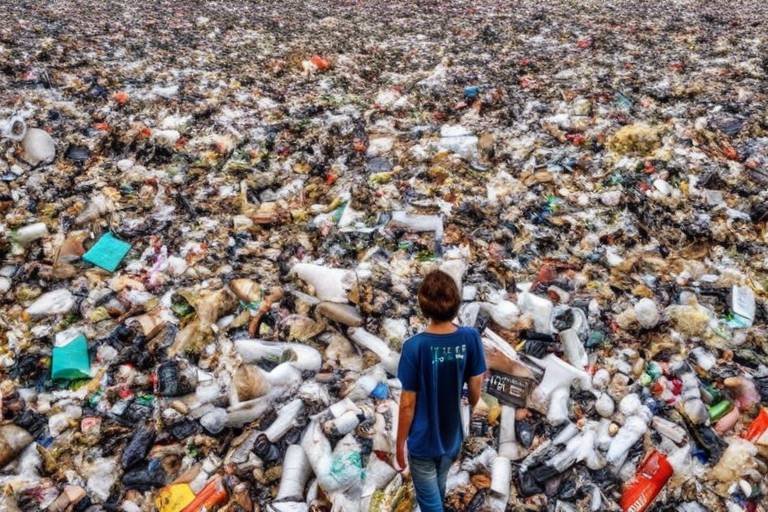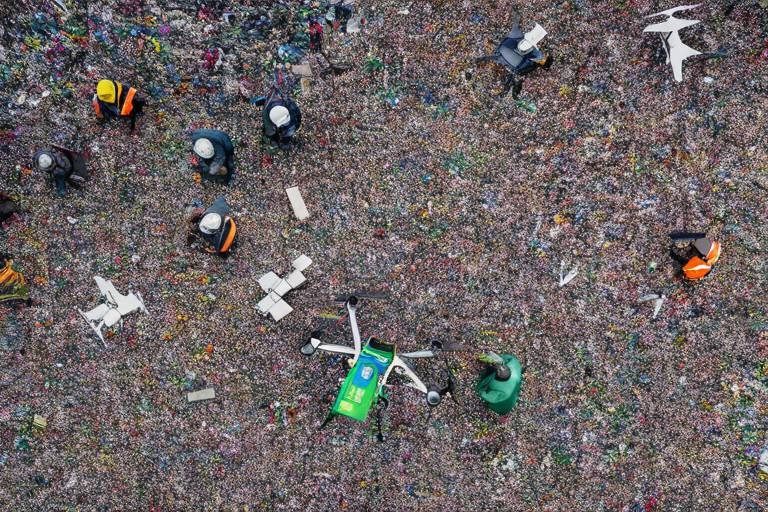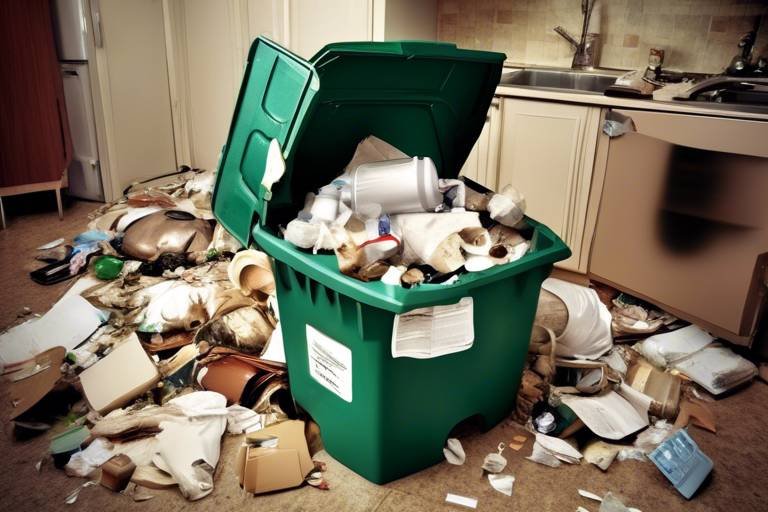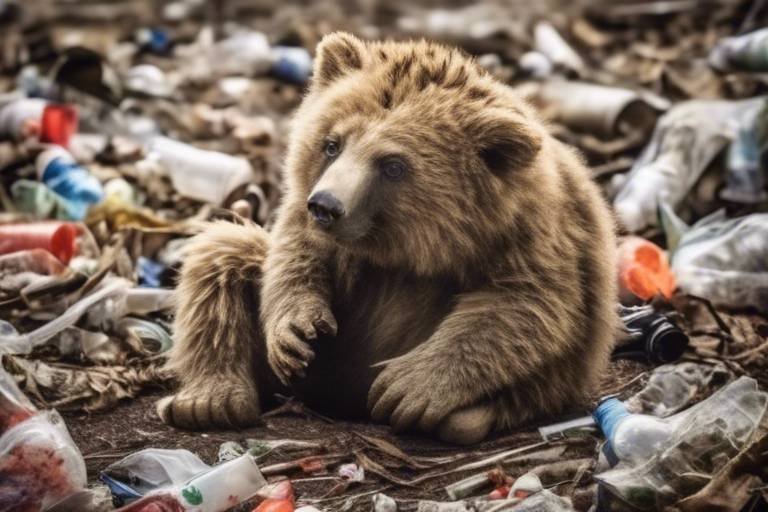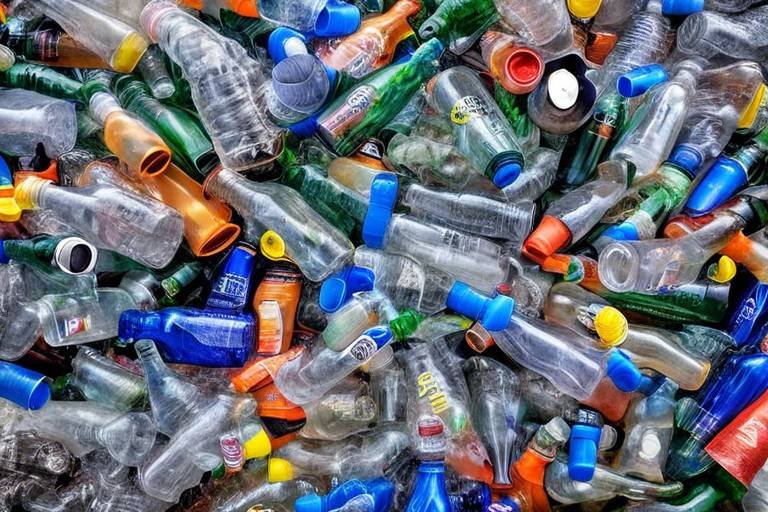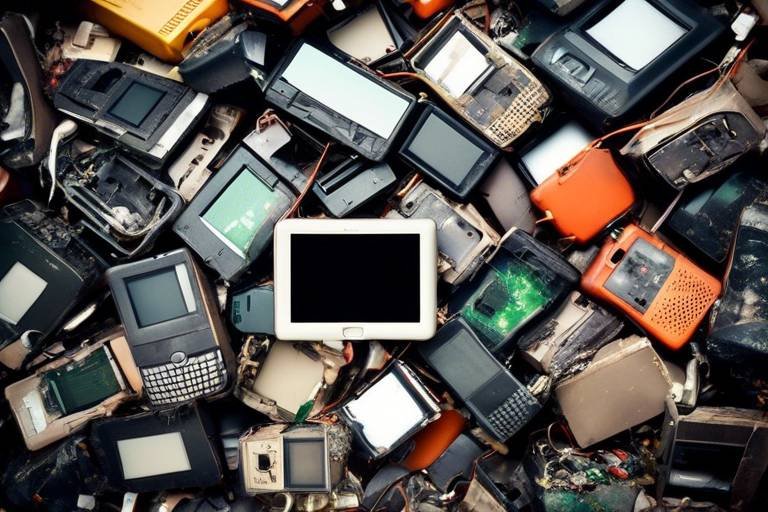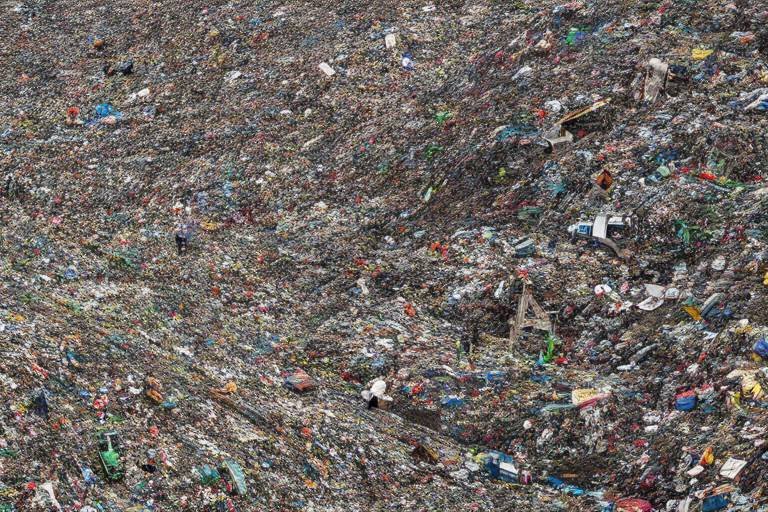The Science Behind Waste Incineration
Waste incineration is not just a method of getting rid of trash; it's a complex science that plays a crucial role in modern waste management and environmental sustainability. Imagine a world where mountains of waste are turned into energy instead of cluttering our landfills. This is the promise of waste incineration. By utilizing high temperatures to burn waste, we can significantly reduce its volume and transform it into a valuable source of energy. This process minimizes our reliance on landfills, which are becoming increasingly unsustainable as urban populations grow and waste generation skyrockets.
At its core, waste incineration operates on the principle of thermal treatment. This means that by applying heat, we can break down waste materials, converting them into simpler compounds. The end products of this process are ash, gases, and energy. The energy produced can be harnessed for electricity generation or used for heating purposes, thereby contributing to a more sustainable energy ecosystem. However, the science behind waste incineration is not merely about burning waste; it involves a series of carefully controlled processes designed to maximize efficiency and minimize environmental impact.
One of the most significant benefits of waste incineration is its ability to reduce the volume of waste by up to 90%. This is a game-changer in waste management, as it alleviates pressure on landfill sites and extends their lifespan. Furthermore, the energy generated from incineration can be used in a variety of ways, making it a versatile solution for energy production. However, it is essential to address the environmental challenges that come with this process. Emissions from incineration can include harmful pollutants if not properly managed. That's why modern incineration facilities employ advanced technologies to control emissions and ensure compliance with environmental regulations.
In summary, waste incineration is a multifaceted process that combines waste management with energy production. It presents a viable alternative to traditional waste disposal methods, offering both environmental and economic benefits. As we continue to grapple with the challenges of waste management in an increasingly populated world, understanding the science behind waste incineration becomes more critical than ever. It’s not just about burning waste; it's about finding innovative solutions for a sustainable future.
- What is waste incineration? - Waste incineration is a thermal treatment process that converts waste materials into ash, gases, and energy through combustion.
- What are the benefits of waste incineration? - The primary benefits include significant waste volume reduction, energy recovery, and decreased reliance on landfills.
- How does incineration impact the environment? - While it reduces waste and generates energy, it can produce emissions that need to be carefully controlled to protect air quality.
- What technologies are used to manage emissions? - Advanced emissions control technologies, such as scrubbers and filters, are used to minimize harmful pollutants released during incineration.
- What happens to the ash produced from incineration? - Bottom ash can be recycled or disposed of safely, depending on its composition and local regulations.

Understanding Waste Incineration
Waste incineration is not just a fancy term thrown around in environmental discussions; it is a critical thermal treatment process that plays a pivotal role in modern waste management. Imagine a world where mountains of garbage are reduced to mere ashes and energy. That's the magic of incineration! By converting waste into energy, incineration minimizes the volume of waste that ends up in landfills, making it a sustainable alternative for managing our ever-growing waste problem.
At its core, waste incineration involves burning waste materials at extremely high temperatures, which effectively eliminates organic materials while reducing the volume of waste by about 90%. This process also generates heat, which can be harnessed to produce electricity or provide heating for residential and commercial buildings. So, not only are we cleaning up our environment, but we are also generating energy in the process!
Now, you might wonder, "Isn't burning waste harmful to the environment?" That's a fair question! While there are concerns about emissions from incineration, modern incineration facilities are equipped with advanced technologies that significantly reduce harmful pollutants. These facilities operate under strict regulations to ensure that emissions are kept to a minimum, making incineration a viable option for waste management.
Moreover, waste incineration also offers a circular economy approach. By recovering energy and materials from waste, we can reduce our dependency on fossil fuels and promote sustainability. It's like turning trash into treasure! The process also allows for the recovery of metals from the bottom ash, which can be recycled and reused, further minimizing waste.
In summary, waste incineration is a powerful tool in our arsenal against waste management challenges. It not only helps reduce the volume of waste but also transforms it into valuable energy resources. As we continue to innovate and improve incineration technologies, we can look forward to a cleaner, more sustainable future.

Incineration Process Overview
Waste incineration is not just about burning trash; it's a sophisticated thermal treatment process designed to tackle the growing challenges of waste management. The entire incineration process can be broken down into several key stages: waste collection, pre-treatment, combustion, and energy recovery. Each of these stages plays a crucial role in ensuring that waste is managed efficiently and that emissions are controlled effectively. Understanding these stages helps to appreciate how incineration contributes to sustainable waste management practices.
The journey begins with waste collection, where various types of waste are gathered from households, businesses, and industrial sites. This stage is vital because the type and quality of waste collected can significantly influence the efficiency of the entire process. Once the waste is collected, it proceeds to the pre-treatment phase. Here, the waste undergoes sorting and segregation to remove non-combustible materials and identify recyclable components. This step not only enhances the efficiency of the incineration process but also reduces the environmental impact by diverting recyclable materials from the incinerator.
Another critical aspect of pre-treatment is the reduction of moisture content. High moisture levels in waste can hinder efficient combustion, resulting in lower energy recovery and increased emissions. By drying the waste before it enters the combustion chamber, facilities can maximize energy output and minimize harmful pollutants. This is especially important because the combustion process itself is the heart of waste incineration, where waste materials are subjected to high temperatures, typically ranging from 850 to 1,200 degrees Celsius. During this stage, waste is transformed into ash, gases, and energy, effectively reducing its volume by up to 90%.
After combustion, the heat generated is captured for energy recovery. This energy can be converted into electricity or used for district heating systems, which provide warmth to residential and commercial buildings. The efficiency of this energy recovery process is a testament to the effectiveness of modern incineration technologies, which aim to reduce reliance on fossil fuels while promoting sustainable energy sources.
In summary, the incineration process is a multi-faceted approach to waste management that not only reduces waste volume but also recovers valuable energy. By optimizing each stage—from collection and pre-treatment to combustion and energy recovery—waste incineration facilities can significantly contribute to a more sustainable future while addressing the pressing issues of waste disposal and environmental impact.
- What types of waste can be incinerated? Most non-recyclable waste, including municipal solid waste, industrial waste, and certain hazardous materials, can be incinerated.
- Is incineration environmentally friendly? While incineration reduces waste volume and generates energy, it can produce emissions. Advanced technologies are used to minimize these emissions and ensure compliance with environmental standards.
- What happens to the ash produced from incineration? Bottom ash can be managed and recycled, while fly ash may require special handling due to potential contaminants.

Waste Collection and Preparation
Waste collection and preparation are critical steps in the waste incineration process. Think of it as the foundation of a house; if the foundation is weak, the entire structure can crumble. The effectiveness of incineration relies heavily on how well the waste is collected, sorted, and prepped before it even reaches the furnace. This stage is not just about gathering trash; it's about ensuring that the materials are suitable for combustion, which in turn minimizes harmful emissions and maximizes energy recovery.
The first step in this process is effective waste collection, which involves gathering waste from various sources, including households, businesses, and industrial sites. This is often done through scheduled pickups or drop-off centers. However, it’s essential to understand that not all waste is created equal. Some materials are more suitable for incineration than others, and that’s where sorting and segregation come into play. By identifying and separating recyclable components, we can enhance the efficiency of the incineration process. For instance, metals and plastics can often be recycled, thereby reducing the amount of waste that needs to be incinerated.
Next comes the preparation phase, where the waste undergoes several treatments before incineration. One of the primary goals during this phase is to reduce the moisture content of the waste. High moisture levels can lead to inefficient combustion, meaning that more energy is wasted and more emissions are produced. To illustrate, let’s consider the analogy of a campfire: if your wood is wet, it won’t burn well, and you’ll end up with more smoke and less heat. Therefore, reducing moisture content is vital for achieving optimal combustion and energy recovery.
In addition to moisture reduction, other preparatory steps may include shredding the waste into smaller pieces to increase surface area, making it easier to ignite and burn completely. This not only enhances combustion efficiency but also ensures that fewer harmful pollutants are released into the atmosphere. Furthermore, the use of advanced sorting technologies, such as optical sorting and air classification, can significantly improve the quality of the waste stream that goes into the incinerator.
To sum it up, the waste collection and preparation phase is not merely a preliminary step; it’s a vital component of the waste incineration process that sets the stage for successful energy recovery and emissions control. By focusing on effective collection and thorough preparation, we can turn what would otherwise be a burden on our landfills into a valuable resource, contributing to a more sustainable future.
- What types of waste can be incinerated? Generally, municipal solid waste, certain industrial wastes, and some medical wastes can be incinerated, but it’s important to check local regulations.
- How does waste incineration affect air quality? While incineration can produce emissions, advanced technologies are in place to minimize pollutants, ensuring compliance with environmental standards.
- What happens to the ash produced from incineration? Bottom ash can be processed and recycled, while fly ash is typically managed through specialized disposal methods to minimize environmental impact.

Sorting and Segregation
Sorting and segregation are crucial steps in the waste incineration process, serving as the foundation for efficient waste management. Imagine trying to bake a cake without sifting the flour; you might end up with a lumpy mess instead of a smooth batter. Similarly, if waste materials aren’t properly sorted, the incineration process can become less efficient, leading to increased emissions and lower energy recovery. By meticulously separating waste into different categories, we can enhance the overall effectiveness of the incineration process. This not only maximizes energy recovery but also minimizes the environmental impact.
The first step in sorting involves identifying recyclable materials. This is where the magic happens! By diverting items like plastics, metals, and paper from the incinerator, we can reduce the volume of waste that needs to be burned. In essence, recycling is like giving waste a second chance at life, preventing it from becoming a burden on our environment. Not only does this reduce the amount of waste sent to incineration, but it also conserves valuable resources and energy that would otherwise be used to produce new materials.
Moreover, segregation helps in preparing the waste for combustion. For instance, removing hazardous materials such as batteries or electronics is vital. These items can release toxic substances when burned, which could harm both the environment and public health. By ensuring that these materials are sorted out, we can protect our air quality and comply with environmental regulations.
In addition to recyclable and hazardous materials, waste can be categorized into organic and inorganic components. Organic waste, such as food scraps, can be treated separately through composting or anaerobic digestion, further reducing the volume that needs to be incinerated. This two-pronged approach of sorting not only streamlines the incineration process but also promotes a more sustainable waste management system overall.
To visualize this process, consider the following table that outlines the different categories of waste and their potential outcomes:
| Waste Type | Sorting Outcome | Environmental Benefit |
|---|---|---|
| Recyclables (Plastics, Metals, Paper) | Diverted for recycling | Conserves resources and energy |
| Hazardous Waste (Batteries, Electronics) | Sent for specialized disposal | Prevents toxic emissions |
| Organic Waste (Food Scraps) | Composted or digested | Reduces landfill waste |
| Inorganic Waste (Glass, Ceramics) | Incinerated | Energy recovery |
In conclusion, sorting and segregation are not just administrative tasks; they are essential components of an effective waste management strategy. By investing time and resources into these processes, we can significantly enhance the efficiency of waste incineration, reduce environmental impact, and contribute to a more sustainable future. It’s a win-win situation that benefits both the planet and our communities!
- What is the main purpose of sorting waste before incineration?
Sorting waste ensures that recyclable and hazardous materials are removed, enhancing the efficiency of the incineration process and minimizing harmful emissions. - Can all types of waste be incinerated?
No, certain materials such as hazardous waste need to be handled separately to prevent toxic emissions during combustion. - How does sorting contribute to environmental sustainability?
By recycling materials and reducing waste volume, sorting helps conserve natural resources and minimizes the need for landfills.

Moisture Content Reduction
Reducing the moisture content in waste is a critical step in the waste incineration process. Think of moisture as the unwanted guest at a party; it takes up space and diminishes the overall experience. When waste has high moisture content, it requires more energy to combust effectively. This not only leads to lower energy recovery but also increases the emissions released into the atmosphere. By lowering moisture levels, we can optimize the combustion process, making it more efficient and environmentally friendly.
The optimal moisture content for efficient combustion typically ranges between 10% to 20%. Waste materials that exceed this range can significantly hinder the incineration process. For instance, wet organic waste can be a real challenge, as it tends to smolder rather than burn, leading to incomplete combustion. This results in the release of harmful pollutants and an increase in the generation of bottom ash.
To achieve effective moisture content reduction, various methods can be employed:
- Mechanical Drying: This method uses mechanical processes to remove moisture from waste materials. Equipment such as rotary dryers can efficiently lower moisture levels before incineration.
- Thermal Drying: In this approach, heat is applied to evaporate moisture. This can be done using hot air or steam, making it a reliable option for high-moisture waste.
- Natural Drying: Sometimes, simply spreading waste in a controlled environment can allow sunlight and air to reduce moisture content naturally. While this method is slower, it is energy-efficient and cost-effective.
Implementing these moisture reduction techniques not only enhances the efficiency of the incineration process but also contributes to a cleaner, more sustainable environment. By ensuring that waste is adequately dried before it enters the incinerator, we can maximize energy recovery and minimize harmful emissions, paving the way for a greener future.
Q1: Why is moisture content important in waste incineration?
A1: Moisture content affects the efficiency of combustion. High moisture levels require more energy to burn waste, leading to lower energy recovery and higher emissions.
Q2: What is the ideal moisture content for waste before incineration?
A2: The optimal moisture content for efficient combustion is typically between 10% to 20%.
Q3: What methods can be used to reduce moisture content in waste?
A3: Common methods include mechanical drying, thermal drying, and natural drying, each with its benefits and applications.
Q4: How does moisture content reduction impact emissions?
A4: Reducing moisture content leads to more complete combustion, which minimizes the release of harmful pollutants and reduces the overall environmental impact of waste incineration.

Combustion Process
The is the heart of waste incineration, a crucial phase where the real magic happens. Imagine a controlled fire that burns waste at temperatures soaring above 850 degrees Celsius (about 1562 degrees Fahrenheit). This intense heat breaks down the waste materials, transforming them into three primary outputs: ash, gases, and energy. It's like turning a pile of unwanted items into something useful, all while dramatically reducing their volume!
During combustion, the waste undergoes a series of chemical reactions. When the waste is ignited, it reacts with oxygen in a process known as oxidation. This reaction releases energy in the form of heat, which is harnessed for various applications. The heat generated can be used to produce steam, which in turn drives turbines to generate electricity or is used in district heating systems. The efficiency of this process is not just about burning waste; it’s about maximizing energy recovery while minimizing environmental impact.
To ensure the combustion process is effective, a few key factors come into play:
- Temperature: Higher temperatures lead to more complete combustion, reducing the formation of harmful byproducts.
- Oxygen Supply: Adequate oxygen is essential for efficient burning. Too little can lead to incomplete combustion, generating more pollutants.
- Residence Time: This refers to the amount of time the waste spends in the combustion chamber. Longer residence times can help ensure that the waste is fully combusted.
Moreover, the design of the incinerator plays a critical role in the combustion process. Modern incinerators are equipped with advanced technologies that optimize the burning of waste. For instance, many facilities use a grate furnace, where waste is fed onto a grate that allows for air circulation beneath it. This setup promotes better combustion by ensuring that the waste is evenly exposed to heat and oxygen.
However, it’s not all about burning waste. The combustion process also generates emissions, including carbon dioxide (CO2), nitrogen oxides (NOx), and dioxins, which can be harmful if not properly managed. This is where emissions control technologies come into play. These technologies are designed to capture and treat harmful gases before they are released into the atmosphere, ensuring that the process remains environmentally friendly.
In summary, the combustion process in waste incineration is a complex yet fascinating sequence of events that transforms waste into energy. By harnessing the heat generated during combustion, we not only reduce the volume of waste but also create a renewable energy source that can power our homes and industries. It's a brilliant example of turning trash into treasure, don’t you think?
What is waste incineration?
Waste incineration is a thermal treatment process that involves burning waste materials at high temperatures to reduce their volume and generate energy.
How does the combustion process work?
The combustion process involves igniting waste materials in the presence of oxygen, leading to a series of chemical reactions that produce heat, gases, and ash.
What are the benefits of waste incineration?
Waste incineration helps reduce landfill usage, generates renewable energy, and minimizes greenhouse gas emissions when managed properly.
Are there environmental concerns with incineration?
Yes, while incineration has benefits, it can produce harmful emissions. Advanced emissions control technologies are essential to mitigate these impacts.

Energy Recovery from Incineration
When we think about waste, our minds often jump to landfills and the mountains of refuse piling up in our communities. But what if I told you that we could turn that waste into something useful? is a fascinating process that not only helps manage waste but also generates electricity and heat, making it a vital player in our quest for sustainable living. This process transforms waste into a valuable resource, significantly reducing our dependence on fossil fuels while minimizing the environmental footprint.
The energy recovery process starts right after the waste is incinerated. As the waste burns at high temperatures, it releases heat energy. This energy is captured and can be utilized in various ways, primarily for electricity generation and district heating systems. Let's explore how these systems work and their benefits.
One of the most exciting aspects of energy recovery from waste incineration is its ability to generate electricity. By harnessing the heat produced during the combustion process, we can drive turbines that produce electrical power. This method not only provides a renewable energy source but also helps to stabilize the grid with a consistent supply of energy. Imagine a city powered by the very waste it produces—it's a win-win situation!
Here are some key benefits of electricity generation from waste incineration:
- Renewable Energy Source: Unlike fossil fuels, which are finite and contribute to greenhouse gas emissions, waste-derived energy is renewable and sustainable.
- Energy Security: By diversifying our energy sources, we can enhance energy security and reduce reliance on imported fuels.
- Reduction of Greenhouse Gas Emissions: Using waste for energy helps lower the overall carbon footprint, contributing to climate change mitigation.
Another remarkable application of energy recovery is through district heating systems. These systems utilize the heat generated from waste incineration to warm residential and commercial buildings. It’s like having a giant furnace that not only reduces waste but also keeps us cozy during those chilly winter months!
District heating systems are particularly beneficial because they:
- Enhance Energy Efficiency: By using waste heat, these systems can operate at higher efficiency rates compared to traditional heating methods.
- Reduce Air Pollution: Centralized heating systems can be designed to meet strict environmental standards, minimizing harmful emissions.
- Lower Heating Costs: Utilizing waste heat can lead to reduced energy bills for consumers, making it an economically attractive option.
In summary, energy recovery from incineration is not just about burning waste; it’s about transforming a problem into a solution. By capturing the heat generated during incineration, we can produce electricity and provide heating, all while reducing the amount of waste that ends up in landfills. This innovative approach to waste management is a crucial step towards a more sustainable future.
Q: What types of waste can be incinerated?
A: Most municipal solid waste can be incinerated, including organic materials, plastics, and paper. However, hazardous waste requires special handling and cannot be treated in standard incineration facilities.
Q: Is energy recovery from incineration environmentally friendly?
A: Yes, when managed correctly, energy recovery from incineration can be environmentally friendly. It reduces landfill use and greenhouse gas emissions compared to traditional waste disposal methods.
Q: How does incineration compare to recycling?
A: While recycling is often preferable as it reuses materials, incineration serves as an effective alternative for waste that cannot be recycled. It reduces waste volume and generates energy, making it a complementary process.

Electricity Generation
Electricity generation from waste incineration is not just a feasible option; it’s a game changer in the quest for sustainable energy solutions. Imagine transforming your everyday trash into a renewable energy source! This innovative process not only reduces the volume of waste but also generates electricity that can power homes and businesses. By harnessing the heat produced during the combustion of waste materials, we can capture and convert this energy into electricity, significantly contributing to our energy grid.
The process begins when waste is incinerated at high temperatures, resulting in the release of heat energy. This heat is then used to produce steam, which drives turbines connected to generators. It's a bit like boiling water to create steam for a locomotive, but in this case, the 'fuel' is our discarded materials. The overall efficiency of this process can be quite impressive, with modern incineration plants achieving energy recovery rates of up to 25-30% of the energy content of the waste.
Furthermore, the benefits of electricity generation from waste incineration extend beyond just energy production. It helps in:
- Reducing landfill dependency: By converting waste into energy, we significantly decrease the volume of waste that ends up in landfills.
- Lowering greenhouse gas emissions: This method of waste management emits fewer greenhouse gases compared to traditional waste disposal methods.
- Enhancing energy security: Utilizing waste as a fuel source reduces our reliance on fossil fuels, paving the way for a more sustainable energy future.
To illustrate the impact of electricity generation from waste incineration, consider the following table showcasing the potential energy output from various types of waste:
| Type of Waste | Energy Content (MJ/kg) | Potential Electricity Output (kWh/ton) |
|---|---|---|
| Municipal Solid Waste | 8-12 | 2,000-3,000 |
| Wood Waste | 15-20 | 3,500-4,000 |
| Industrial Waste | 10-15 | 2,500-3,500 |
As we can see, the potential for generating electricity from waste is vast and varied, making it a compelling component of our renewable energy strategy. This not only helps in managing waste effectively but also contributes to a cleaner, greener planet. So, the next time you throw something away, remember: it could very well be powering your neighbor's home!
Q1: How much electricity can be generated from waste incineration?
A1: The amount of electricity generated depends on the type of waste and the efficiency of the incineration plant. On average, waste incineration can produce between 2,000 to 4,000 kWh per ton of waste.
Q2: Is electricity generation from waste incineration environmentally friendly?
A2: Yes, when managed properly, waste incineration can be environmentally friendly. It reduces landfill use, lowers greenhouse gas emissions, and generates renewable energy. However, stringent emissions control technologies are essential to minimize pollutants.
Q3: What happens to the ash produced from incineration?
A3: The ash produced can be managed and recycled. Bottom ash can be processed to recover valuable materials, while fly ash is treated to meet environmental standards before disposal.

District Heating Systems
District heating systems are a remarkable innovation in energy distribution, offering a sustainable solution to meet heating needs for residential and commercial buildings. Essentially, these systems utilize the heat generated from waste incineration, transforming it into a source of warmth that can be distributed through a network of insulated pipes. Imagine a cozy blanket of warmth that wraps around entire neighborhoods, reducing the reliance on individual heating systems. This not only enhances energy efficiency but also significantly cuts down on greenhouse gas emissions.
One of the most significant advantages of district heating is its ability to centralize energy production. By harnessing the heat from waste incineration, cities can provide a reliable and consistent heat supply, which is particularly beneficial during the colder months. The process begins at the incineration facility, where waste is burned at high temperatures, producing heat that is then transferred to water. This hot water is pumped through a series of pipes to homes and businesses, providing them with the necessary warmth.
Moreover, district heating systems can be designed to integrate with other renewable energy sources, such as solar or geothermal energy. This flexibility allows for a more resilient energy infrastructure, capable of adapting to changing energy demands and environmental conditions. For instance, during peak heating periods, additional heat can be sourced from solar thermal panels or geothermal wells, further reducing the carbon footprint.
However, the implementation of district heating systems is not without its challenges. The initial investment required for infrastructure development can be substantial. Local governments and energy providers must collaborate effectively to design and build these systems, ensuring they meet the needs of the community. But once established, the long-term benefits, including lower energy costs and reduced environmental impact, far outweigh these initial hurdles.
In summary, district heating systems represent a forward-thinking approach to energy distribution, leveraging the heat generated from waste incineration. They not only provide an efficient and sustainable heating solution but also contribute significantly to reducing the overall carbon footprint of urban areas. As cities continue to grow and the demand for energy increases, district heating systems will play a crucial role in creating a more sustainable future.
- What is district heating? District heating is a system that distributes heat generated from a central source, such as a waste incineration facility, to multiple buildings through a network of insulated pipes.
- How does district heating work? It works by transferring heat from hot water produced during waste incineration to residential and commercial buildings through a network of pipes.
- What are the benefits of district heating? Benefits include increased energy efficiency, reduced greenhouse gas emissions, and lower heating costs for consumers.
- Can district heating systems use renewable energy? Yes, they can integrate with other renewable energy sources like solar and geothermal energy to enhance sustainability.

Environmental Impact of Incineration
When we talk about waste incineration, it’s crucial to recognize that while it offers a plethora of benefits, it also brings about some significant environmental challenges. The process of burning waste can lead to the release of harmful emissions, which is a concern for many communities and environmentalists alike. However, with the right technologies and regulations in place, these challenges can be effectively managed.
One of the primary environmental concerns surrounding waste incineration is the emission of pollutants. During the combustion process, various gases, including carbon dioxide (CO2), nitrogen oxides (NOx), and particulate matter can be released into the atmosphere. These emissions can contribute to air quality degradation and pose health risks to nearby populations. To mitigate these risks, modern incineration facilities are equipped with advanced emissions control technologies which play a vital role in minimizing pollutant release. These technologies include:
- Electrostatic Precipitators (ESPs): These devices capture particulate matter from the flue gases before they are released into the atmosphere.
- Scrubbers: Scrubbers are used to remove sulfur dioxide and other acidic gases from the emissions.
- Catalytic Converters: These converters help in reducing nitrogen oxides, converting them into harmless nitrogen and water vapor.
Another critical aspect of incineration's environmental impact is the management of bottom ash, which is the residual material left after the combustion of waste. This ash can contain heavy metals and other hazardous substances that, if not managed properly, can leach into the soil and groundwater, causing environmental contamination. Therefore, effective bottom ash management strategies are essential. These strategies can include:
| Management Strategy | Description |
|---|---|
| Recycling | Processing bottom ash to recover metals and other reusable materials. |
| Landfilling | Disposing of non-recyclable ash in specially designed landfills to prevent leachate contamination. |
| Stabilization | Treating bottom ash to reduce its leachability and toxicity. |
Furthermore, the overall environmental footprint of incineration can be influenced by the type of waste being processed. For instance, the incineration of plastics and other synthetic materials can produce more harmful emissions than the burning of organic waste. Hence, sorting and segregation of waste before incineration is paramount. This not only improves the efficiency of the incineration process but also significantly reduces the potential for harmful emissions.
In conclusion, while waste incineration is a powerful tool in the fight against waste accumulation and can significantly contribute to energy recovery, it is not without its environmental challenges. The key lies in implementing robust regulations, investing in advanced technologies, and promoting responsible waste management practices. By doing so, we can harness the benefits of incineration while minimizing its impact on our environment.
1. What are the main pollutants released during waste incineration?
The main pollutants include carbon dioxide (CO2), nitrogen oxides (NOx), sulfur dioxide (SO2), and particulate matter. Advanced technologies are used to control and reduce these emissions.
2. How is bottom ash managed after incineration?
Bottom ash can be recycled, landfilled, or treated to reduce its toxicity. Proper management is essential to prevent environmental contamination.
3. Can incineration reduce the volume of waste significantly?
Yes, incineration can reduce the volume of waste by up to 90%, making it a highly effective waste management solution.
4. Are there any health risks associated with incineration?
While there are potential health risks due to emissions, modern incineration plants are equipped with technologies designed to minimize these risks and comply with environmental standards.

Emissions Control Technologies
In the quest for sustainable waste management, play a pivotal role. These technologies are designed to minimize the release of harmful pollutants during the waste incineration process, ensuring that the air we breathe remains clean and safe. By utilizing advanced filtration and scrubbing systems, incineration facilities can significantly reduce emissions of toxic substances such as dioxins, furans, and heavy metals. But how do these systems actually work?
At the heart of emissions control are several key technologies that work in tandem to capture and neutralize pollutants. For instance, flue gas treatment systems are employed to treat the gases emitted during combustion. These systems often include:
- Electrostatic Precipitators (ESPs): These devices use electrical charges to remove particulate matter from the flue gas, ensuring that harmful particles do not escape into the atmosphere.
- Fabric Filters: Also known as baghouses, these filters trap dust and other particulates, effectively cleaning the air before it is released.
- Scrubber Systems: These systems utilize liquid to remove acid gases, such as sulfur dioxide (SO2) and hydrochloric acid (HCl), from the flue gas stream, reducing their environmental impact.
Moreover, the integration of Selective Catalytic Reduction (SCR) technology allows for the conversion of nitrogen oxides (NOx) into harmless nitrogen and water vapor, further enhancing the environmental performance of waste incineration plants. This process not only complies with strict environmental regulations but also contributes to a reduction in greenhouse gas emissions.
To put this into perspective, consider the following table that summarizes the effectiveness of various emissions control technologies:
| Technology | Pollutants Removed | Efficiency Rate (%) |
|---|---|---|
| Electrostatic Precipitators | Particulate Matter | 99% |
| Fabric Filters | Particulate Matter | 99.9% |
| Scrubber Systems | Acid Gases (SO2, HCl) | 95-99% |
| Selective Catalytic Reduction | Nitrogen Oxides (NOx) | 70-90% |
These technologies not only help in meeting regulatory standards but also foster public trust in waste management practices. By investing in state-of-the-art emissions control technologies, incineration facilities demonstrate their commitment to environmental stewardship. Nonetheless, the journey doesn't end here. Continuous research and development are essential to enhance these technologies, making them even more effective in combating air pollution.
Q: What are the main pollutants emitted during waste incineration?
A: The main pollutants include dioxins, furans, nitrogen oxides (NOx), sulfur oxides (SOx), and particulate matter.
Q: How do emissions control technologies impact the environment?
A: These technologies significantly reduce harmful emissions, thereby protecting air quality and public health.
Q: Are there any regulations governing emissions from incineration?
A: Yes, there are strict environmental regulations that incineration facilities must comply with to limit emissions and ensure public safety.
Q: Can waste incineration contribute to renewable energy?
A: Absolutely! Waste incineration can generate energy, which can be harnessed for electricity and heating, contributing to renewable energy sources.

Bottom Ash Management
Bottom ash management is a critical aspect of the waste incineration process, as it deals with the residue left after the combustion of waste materials. This residue, often overlooked, can have significant environmental implications if not handled properly. After the waste is incinerated at high temperatures, the remaining bottom ash constitutes about 10-20% of the original waste volume. While it may seem like just waste, bottom ash can actually be a valuable resource if managed correctly.
One of the primary challenges of bottom ash management is ensuring its safe disposal and minimizing its environmental impact. The composition of bottom ash can vary widely, containing metals, glass, and other materials that can be recycled or repurposed. Proper management practices are essential to extract these valuable resources while preventing harmful substances from leaching into the environment.
To effectively manage bottom ash, several strategies can be employed:
- Material Recovery: This involves extracting recyclable materials from the bottom ash, such as metals that can be melted down and reused in manufacturing processes.
- Use in Construction: Bottom ash can be utilized as a lightweight aggregate in concrete or as a fill material in construction projects, thereby reducing the need for virgin materials.
- Landfill Alternatives: Instead of sending bottom ash to landfills, innovative technologies are being developed to treat and stabilize the ash, making it safer for use in various applications.
However, the management of bottom ash does not stop at recovery and recycling. It is also crucial to monitor and control any potential leachate that could result from the ash, as it may contain toxic elements. Implementing stringent regulations and advanced treatment technologies ensures that bottom ash is managed responsibly. For instance, leachate treatment systems can be put in place to prevent harmful substances from contaminating soil and groundwater.
In conclusion, effective bottom ash management not only contributes to sustainable waste management practices but also plays a vital role in promoting resource recovery and minimizing environmental impacts. By treating bottom ash as a resource rather than a waste product, we can pave the way for a more sustainable future.
1. What is bottom ash?
Bottom ash is the residue left after waste is incinerated at high temperatures. It can contain metals, glass, and other materials that can potentially be recycled.
2. How is bottom ash managed?
Bottom ash is managed through various strategies, including material recovery, use in construction, and treatment to prevent leachate contamination.
3. Can bottom ash be recycled?
Yes, bottom ash can be recycled. Metals can be extracted and reused, and the ash can be used as lightweight aggregate in concrete or as fill material in construction projects.
4. What are the environmental concerns associated with bottom ash?
The main environmental concerns include the potential leaching of toxic substances into the soil and groundwater, which necessitates careful management and treatment.
Frequently Asked Questions
- What is waste incineration?
Waste incineration is a thermal treatment process that reduces the volume of waste by burning it at high temperatures. This process not only minimizes the amount of waste sent to landfills but also transforms waste into energy, contributing to sustainable waste management practices.
- How does the incineration process work?
The incineration process involves several key stages: waste collection, pre-treatment, combustion, and energy recovery. Each stage plays a crucial role in ensuring that waste is efficiently managed and that harmful emissions are controlled throughout the process.
- What happens during the combustion process?
During combustion, waste materials are burned at extremely high temperatures, converting them into ash, gases, and energy. This is the core of waste incineration, where the transformation of waste into usable energy occurs.
- Can energy be recovered from incineration?
Absolutely! Energy recovery from incineration captures the heat generated during combustion, which can then be converted into electricity or used for district heating. This process enhances overall energy efficiency and provides a renewable energy source.
- What are the environmental impacts of waste incineration?
While waste incineration has benefits, it also poses environmental challenges, such as emissions and ash disposal. It's essential to implement strict regulations and advanced technologies to minimize these impacts and protect public health.
- How are emissions controlled during incineration?
Emissions control technologies are vital for reducing the release of harmful pollutants during the incineration process. These technologies ensure compliance with environmental standards, helping to safeguard both the environment and public health.
- What is done with the bottom ash produced from incineration?
Bottom ash, the residue left after incineration, must be managed properly to minimize environmental impact. Effective management includes recycling valuable materials contained within the ash and ensuring its safe disposal.




